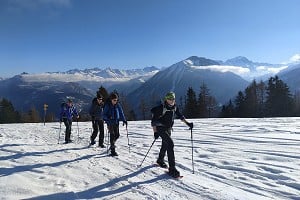
I return to my 'other half' and his interest in snowshoes. I had suggested that given the white-out conditions in the mountains that we went for a short snowshoe walk above our village in Switzerland. It would be safe and would at least give us some fresh air. Off we set with Martin refusing to put on these 'ridiculous contraptions'. Heaven forbid that a IFMGA Mountain Guide be seen in them, and of course the inevitable happened. I with my state-of-the-art lightweight snowshoes, in a rather fetching shade of powder blue, was skipping along on the surface exclaiming over the beauty of the shimmering crystals while he was sinking thigh deep. He lasted not even five minutes, and stomped off, sorry, floundered off, in a strop cursing my suggestion that he indulged in an activity which only those with no ability on skis would ever think of trying!
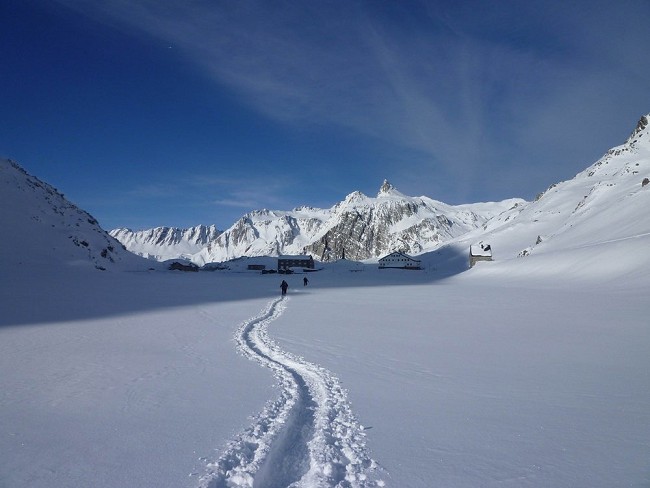
Back with Martin; we are now high above Chamonix and he is continuing his traverse of the neve slope in my new snowshoes, while I cringe in anticipation of the consequences of a slip. To be honest I guess he would have ended up with no more than damaged pride, and a lot of bruising but you know how these things can appear. At first he made his way tentatively across the slope, which was roughly 40 degrees at its steepest, then realising that he was getting plenty of 'bite' he started crossing with a firm confident step. Then something amazing happened, he turned with a broad grin and exclaimed:
"Blimey, these snowshoe things are pretty cool, no problem gripping here! Now, wonder what I can try next?"
Ok, once upon a time they looked like something you might use for an early game at Wimbledon, and I do have friends who constantly tease when I suggest I am off for a spot of snowshoeing. 'Oh, getting the tennis racquets out then?' But snowshoes have come a long way since the French first referred to them as 'racquettes'; they believed they resembled something you would use to play jeu de paume - an early form of tennis. Today's snowshoes are made of hi-tech materials and come in many shapes, sizes, and colours. For the fashion conscious you can easily tailor your snowshoe collection (let's face it one pair is never enough) to match your winter wardrobe. I have seen them in pink, lime green, orange, blue, beige, yellow, black, and grey.
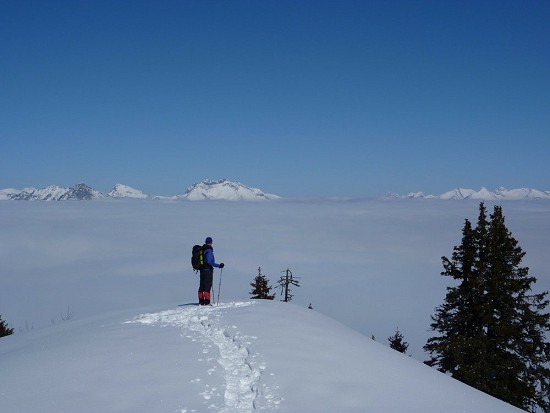
You can buy snowshoes with aluminium surrounds for particularly cold climates such as Scandinavia and North America, or composite plastic models for the more temperate mountain weather in the Alps. They are a pleasure to wear and without doubt a fantastic way to move around a snow covered landscape.
I would like to point out at this stage that I am a keen ski mountaineer, and winter climber, and I am not spending time snowshoeing because I am incapable of doing any other winter activity! I generally find that those who have never experienced snowshoeing have several reactions to the sport ranging from a disparaging 'snort', to a dismissive 'chortle', or perhaps in more extreme responses from hardened skiers 'I'd rather be seen dead on a snowboard than spotted wearing snowshoes'.
Some Snowshoe History
The aim of course was to travel on the surface of the snow pack rather than sinking knee or thigh deep. Any of you who have tried to walk anywhere in deep snow will know that although it looks inviting it doesn't take long before you are exhausted, perspiring heavily, viewing the world through an angry red mist and cursing the idiot who suggested you try to get to the climb!
Nature, as is often the case, provided examples of efficient snow travel. Hares evolved with oversized feet, in this case, also very fluffy, even the sole of their feet is covered in hair, and it all helps to keep them on the surface of the snow. Otzi and his pals probably gave this some thought and came up with their own version of oversized shoes. Anyway, to get back to the history - two groups of snowshoe pioneers diverged early on, setting patterns which can still be seen today. One group abandoned the snowshoe as it migrated north to what is now Scandinavia, eventually turning the design into the forerunner of the Nordic ski. The other lot went northeast, eventually crossing the Bering Strait into North America.
Get the Gear - Snowshoes
Two best selling snowshoe models....TSL Rando 226 Snowshoes
A classic all-round snowshoe with a thermoplastic toe-bale and ankle strap. The hourglass shape allows for an easier stride and the foot plate is easily fitted to the boot size with a quick turn of the adjustment system. The wire climbing arc provides heel lift when ascending and reduces fatigue in the calf muscles. Grip on steep or icy terrain is provided by the aluminium front claw and 6 steel crampon spikes. Aluminium claws (AKA Harscheisen) for extreme icy conditions are available.
More info on the Allcord Website.
Kahtoola MTN 24 Snowshoes
The MTN24 is Kahtoola's answer for the everyday snowshoe, but it's simply not that ordinary. Our patented SKYHOOK® step-in Technology means you can step from ice to snow with ease just by clicking the boot-mounted Eight-Point Trail Crampon into the integrated SKYHOOK® step-in binding. Yes, we said WITH EASE. Our boot-mounted Eight-Point Trail Crampon fits almost all your footwear, so adventures are dictated by terrain, not your footwear.
More info on the Kahtoola Website.
Today it is the French, who are leading the snowshoe renaissance, but we Brits have been at this snowshoe lark for a few hundred years. In 1757 during the war against the French and Native Americans in what is now the United States there took place the 'Battle on Snowshoes'. In New York State, near Lake George, British Ranger companies led by Robert Rogers came up against French troops and Indians allied to France. The battle was so named because the British were wearing snowshoes at the time. The French noted that they were at a disadvantage, being without snowshoes and 'floundering in snow up to their knees'. The British with their ability to move quickly were able to maintain their positions on high ground. Interesting don't you think that today the Americans and French are leading the way and most of we Brits wouldn't recognise a snowshoe if it sat up and grabbed us!
In case you are wondering the 'other half' survived his death defying crossing of the slope high above Chamonix. He even managed to complete the day without any other Mountain Guides spotting his conversion to those 'ridiculous contraptions'! Martin after years of throwing himself at and down steep mountains has a range of 'minor' bodily impairments such as knackered knees. I could expand on this list but I haven't got all day. Basically, he has no cartilage left and is not keen on walking downhill. It's a condition that many mountain folk suffer from and after weeks of snowshoeing last winter I can say that I didn't suffer from sore knees once. Think about it – the large surface size of the snowshoe, essentially a flotation device, spreads any impact. Then there's the snow itself which is another shock absorber.
It seems a shame to me that some folk seem embarrassed at the idea of snowshoeing as if it's not something that 'proper' mountain folk would do. Hey, if it was good enough for hard core British troops its good enough for me. And of course cool dude snowboarders find no problem with snapping on a pair of snowshoes. In fact, the resurgence of snowshoeing over the last few years has been credited in part to snowboarders and their desire to get to otherwise inaccessible off-piste areas.
I regularly see boarders in the Alps with snowshoes strapped to their packs. In fact, just a few weeks ago a young Mountain Guide knocked at our apartment door and with a rather sheepish grin asked if he could borrow a set of snowshoes as he needed to get a client to a climb in Italy and with 40cm of fresh snow he knew he wouldn't make it without the 'shoes'. As it was they had a great day and completed the climb.
You can also have fun just choosing your snowshoes. Happy hours spent deciding on size, usually based on the kind of snow you expect to mainly be traveling through, larger set for powder, smaller for firm snow. The chosen size also depends on your weight, the heavier the person the larger the snowshoe. If you get into it expect to have several pairs for different snow days, but with snowshoes costing from as little as £45 you can probably afford it. The more expensive models will cost over £100. If visiting the Alps you don't even have to buy, in almost every resort, you can hire snowshoes for around £8.
The snowboarding influence is also apparent in the bindings. You can either have snap buckle bindings, similar to a rucksack strap buckle, or a ratchet device exactly like a snowboard binding. Put on a pair and it opens up a whole new world of exploration. All you need on your feet is a decent pair of walking boots and a set of poles. I regularly see whole families wandering through magical snow covered forests or across high meadows enjoying the views normally only afforded to mountaineers or skiers. No experience is necessary and with a little guidance you can soon pick up the skills. You just need to be able to put one foot in front of the other.
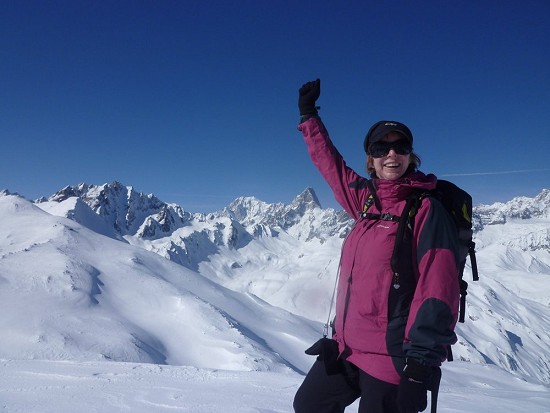
There is also the myth that it's all hard work. Ok, maybe if you happen to have to break a trail, but if there is a trail already there, and there often is, then it's no harder than normal walking and considerably easier than if you weren't wearing snowshoes. One word of caution, of course, is that you must be aware of any avalanche risk, take the necessary precautions and be wearing appropriate warm and waterproof clothing. I never venture out without wearing an avalanche transceiver so that I can 'find' and be 'found' should there be an incident. Writing as an International Mountain Leader, qualified to take people snowshoeing, I would suggest that you might think about either getting some good advice about your choice of route or hiring a Leader to take you into the mountains.
Meanwhile, back with Martin's 'excellent snowshoe adventure', we have now encountered a granite outcrop covered in snow and ice in the forest. I set off, weaving effortlessly through the trees in deep snow, heading straight for the rock. My normally fearless companion expresses amazement that I'm even considering climbing it in 'clumsy' shoes. Undeterred I stride forward and place the front claws of my snowshoes onto the rock, I quickly find purchase on a small lip, in the same way I would normally use the front points of my crampons and start the climb. I'm not suggesting for a minute that they replace crampons on technical ground, just think of it as the equivalent of bouldering in the snow.
Because snowshoes have 'free' heels, combined with three front claws, as well as around six studs on the base you get fantastic grip. The free heel also means that once you start climbing the shoe falls away and hangs below you allowing the 'claws' to bite into any snow or ice. I gain the summit of the boulder in a few minutes, having enjoyed some technical climbing and I'm off again into the woods. Behind me more expressions along the lines of 'didn't know you could do this on snowshoes'. So the finally verdict on snowshoes from a hard man of the mountains? 'I guess they're OK'. He always was a master of the understatement.
A final word; the Alps may be leading the way when it comes to the numbers of people taking up snowshoeing but in recent winters strange tracks have been seen in Scotland. They look remarkably like snowshoes prints to me!
Join us for a snowshoeing trip at www.tracks-and-trails.com!

About Lindsay Cannon
Lindsay Cannon is a broadcaster who has worked on a wide range of TV and radio programmes dealing with subjects ranging from social and welfare issues to the environment and outdoor pursuits. Lindsay's work has included producing 'The Adventure Show' on BBC Two Scotland, which covers competitive adventure racing events; presenting BBC Two's 'Tracks' for network television, which saw her taking part in everything from rock climbing to caving and sea kayaking; and working for BBC One's 'A Week In The Country', covering environmental issues across the UK. Lindsay, who grew up in the Galloway countryside, has also spent 12 years as a presenter of 'Landward' on BBC One Scotland, dealing with rural affairs. In addition she has presented programmes for BBC Radio Four, the World Service, BBC Radio 5 Live, and BBC Radio Scotland.
Lindsay is a fully qualified International Mountain Leader working mainly in the French, Swiss and Italian Alps. She is the co-founder of Tracks and Trails adventure holidays.


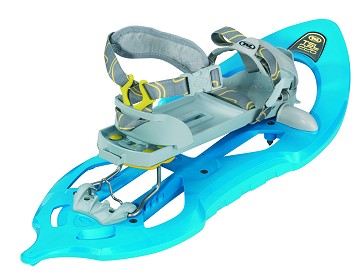
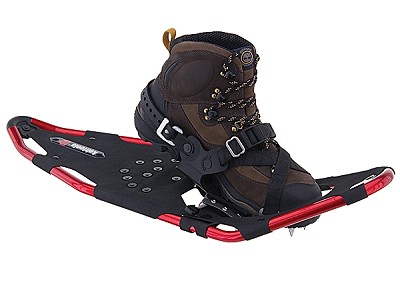

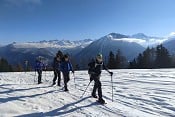
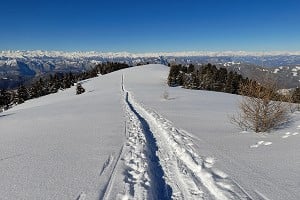
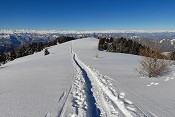
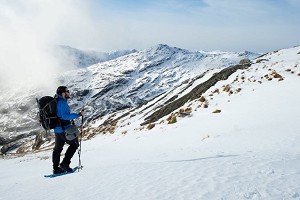

Comments